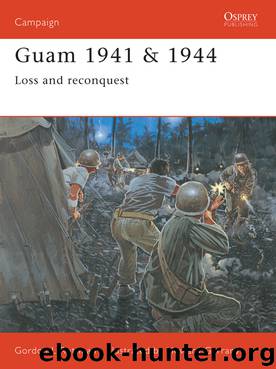Guam 1941 & 1944 by Gordon L. Rottman

Author:Gordon L. Rottman
Language: eng
Format: epub
Tags: Guam 1941 & 1944: Loss and Reconquest
ISBN: 9781472800114
Publisher: Bloomsbury Publishing
Service troops occupy Japanese trenches on the Southern Beaches. Knocked out amtracs still litter the reef. Orote Peninsula is in the far left background.
The 3rd MarDiv’s lead amphibian tanks came ashore on the Northern Beaches at 08.29hrs. The Division’s four beaches were situated between Adelup and Asan Points, described as the “devil’s horns.” 3/3 and 2/3 (3rd CT Reserve) landed on Beach “Red 1” while 1/3 landed on “Red 2”. The 21st CT landed on “Green” in a column of battalions (3rd, 2nd, 1st) and the 9th CT came ashore on “Blue” in the same order as the 21st. Units landing on “Green” and “Blue” had to cross broad rice paddies overlooked by Japanese-infested ridges. It was planned for the 3rd Marines’ three battalion 81mm mortar platoons to be combined upon landing into a provisional Mortar Groupment on the boundary between “Red 1” and “2” to concentrate fire on Adelup Point. This proved unnecessary because of lighter than expected resistance there. The assistant division commander was ashore by late morning and the division commander assumed control of operations ashore at 17.15hrs.
The 1st Prov MarBde landed on the Southern Beaches at 08.32hrs. 1/22 landed on Beach “Yellow 1” adjacent to Agat Town and 2/22 on “Yellow 2”. The reserve 3/22 came ashore on “Yellow 1”. 2/4 landed on “White 1” north of Bangi Point and 1/4 on “White 2” followed by the reserve 3/4.
On the Northern Beaches the 3rd Marines’ north flank was able to push inland only 200–300yds (183–274m) and were held up by defenses on Chonito Cliff and Bundschu Ridge on the north flank. The 21st Marines in the center cleared Asan Town and gained a foothold on the face of the Fonte Plateau 1,600yds (1,463m) inland. A 200yd (183m) wide gap existed between the two regiments in the gorge of the north fork of the Asan River. The maze of ravines, and coral outcroppings, and tangled vegetation was more of an obstacle to closing the gap than enemy resistance. The two regiments made major efforts to link up over the next bitter days, but this was not accomplished until after the Japanese counterattack of 25/26 June. On the south flank the 9th Marines pushed almost the same distance inland and down the coast toward Apra Harbor. W-Day nightfall found the battalions positioned, left to right: 3/3, 2/3, 1/3, 2/21, 3/21, 1/9, and 2/9. Only 1/21 and 3/9 were held in Division Reserve. The beachhead was about 1,600 by 4,000 yards (1,463 x 3,658m). The Division had lost 105 killed in action (KIA), 56 missing in action (MIA), and 536 wounded in action (WIA). This equated to the loss of almost a battalion, but aggressive leadership pushing the troops forward was credited with reducing casualties: by the time the Japanese called in mortar and artillery fire the targeted Marines had often already rushed forward. Nine LVTs were lost during the landing and more were lost ashore on the first day. The Japanese had abandoned the beach positions, apparently because
Download
This site does not store any files on its server. We only index and link to content provided by other sites. Please contact the content providers to delete copyright contents if any and email us, we'll remove relevant links or contents immediately.
| Africa | Americas |
| Arctic & Antarctica | Asia |
| Australia & Oceania | Europe |
| Middle East | Russia |
| United States | World |
| Ancient Civilizations | Military |
| Historical Study & Educational Resources |
Flight by Elephant(1481)
The Rise and Fall of the Third Reich: A History of Nazi Germany by William L. Shirer(1382)
Unbroken: A World War II Story of Survival, Resilience, and Redemption by Hillenbrand Laura(1099)
German submarine U-1105 'Black Panther' by Aaron Stephan Hamilton(1018)
Last Hope Island by Lynne Olson(933)
A Bridge Too Far by Cornelius Ryan(928)
War by Unknown(904)
The Victors - Eisenhower and His Boys The Men of World War II by Stephen E. Ambrose(901)
The Guns at Last Light: The War in Western Europe, 1944-1945 by Rick Atkinson(887)
Rogue Heroes: The History of the SAS, Britain's Secret Special Forces Unit That Sabotaged the Nazis and Changed the Nature of War by Ben Macintyre(883)
0060740124.(F4) by Robert W. Walker(871)
The Hitler Options: Alternate Decisions of World War II by Kenneth Macksey(865)
The Railway Man by Eric Lomax(846)
All the Gallant Men by Donald Stratton(814)
Hitler's Vikings by Jonathan Trigg(808)
A Tragedy of Democracy by Greg Robinson(800)
Churchill's Secret War by Madhusree Mukerjee(796)
Hitler's Armies by Chris McNab(781)
We Die Alone: A WWII Epic of Escape and Endurance by David Howarth & Stephen E. Ambrose(745)
